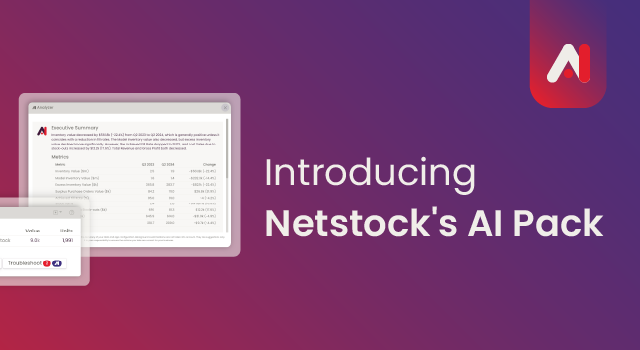Accurate demand forecasting gives businesses a competitive edge, enabling them to meet customer demand without risking stock-outs. If forecasts underestimate demand, stock shortages can result, leading to missed sales and dissatisfied customers. On the other hand, overstocking ties up resources and can lead to waste, particularly for perishable or seasonal items.
Take a company that supplies seasonal products like Christmas treats or Easter eggs—incorrect forecasting for such items can lead to significant financial losses, especially when products have a short shelf life.
By improving forecast accuracy, businesses can optimize inventory levels, reduce waste, and enhance customer satisfaction. Netstock offers advanced forecasting tools that help you streamline operations, boost accuracy, and make more informed supply chain decisions.
Techniques for boosting demand forecasting accuracy
Accurate demand forecasting is essential for optimizing inventory, and here are a variety of qualitative and quantitative techniques they can apply:
Quantitative Techniques
- Time series analysis: Time series analysis predicts future demand based on historical data, identifying recurring patterns and trends. It is a valuable forecasting tool in cyclical demand environments.
- ARIMA (AutoRegressive Integrated Moving Average): A popular method for understanding the underlying patterns in time series data. ARIMA is commonly used in stable-demand environments with clear trends.
- Exponential smoothing: This applies decreasing weights to past data, with the most recent data points most heavily weighted. It’s ideal for short-term forecasts where demand fluctuates. Exponential smoothing flattens random variations. Some variants can predict seasonal trends.
- Machine learning models: Advanced machine learning models have revolutionized demand forecasting by processing large, complex datasets that were previously difficult to handle. They can recognize nonlinear relationships and detect patterns that traditional techniques might miss.
- Neural networks: These powerful tools can simulate human learning. They learn from data, identifying complex, hidden patterns and correlations across various inputs. Businesses can use them to make accurate predictions. They are useful when dealing with external variables, like marketing efforts and economic indicators, that traditional models don’t effectively capture.
Qualitative Techniques
Qualitative methods provide valuable insights when historical data is limited, especially for new product launches. Qualitative techniques include:
- Expert opinion: Industry experts or internal teams can provide valuable guidance for new or evolving markets. Experts can offer insights into industry trends, consumer behavior, and external factors, like economic shifts or regulatory changes that could influence demand.
- Market research: Surveys, focus groups, and competitor analysis offer direct feedback from consumers.
Tools for enhancing demand forecasting accuracy
Two enhancements advancing demand forecasting accuracy include AI-powered software and integrated predictive analytics.
AI-Powered software
AI-powered demand forecasting tools, like Netstock, use powerful automation features to streamline forecasting. These tools can automatically collect, clean, and organize large datasets, saving time and reducing errors. These systems integrate historical sales data, supplier lead times, and market trends to create comprehensive and current forecasts.
AI tools analyze vast amounts of data, applying advanced algorithms to detect patterns and trends that traditional methods might overlook. AI-powered software continuously learns and adapts as new data is introduced. The result is more precise forecasts, even in volatile markets.
Netstock’s demand and supply planning solutions provide accurate inventory and forecasting insights. Businesses can monitor demand fluctuations and dynamically adjust their forecasts.You can forecast by sub-SKU attributes, channel, customer, or region, and work in any unit of measure. Plan on multiple dimensions to generate product and channel-specific forecasts in monthly, weekly, and even daily buckets, creating symmetry between forecasting and planning executives in your business. Netstock uses scenario planning to model demand scenarios, like supply chain disruptions or consumer behavior changes. Real-time scenarios will help you to make informed decisions.
Integration of predictive analytics
Predictive analytics tools forecast outcomes using historical data, statistical algorithms, and machine learning. You can take your business beyond trend analysis by integrating predictive analytics with your demand forecasting. These tools can help you to gain a deeper understanding of the factors driving demand.
Machine learning models, such as decision trees, random forests, and neural networks, can automatically identify hidden patterns and correlations in large datasets. By analyzing multiple variables, you can create more accurate forecasts.
Predictive analytics can help your business move from reactive to proactive demand forecasting. Identify potential demand shifts before they happen to make smarter inventory management, production schedules, and supply chain decisions. Predictive models can also assess the likelihood of various outcomes and recommend optimal stock levels, reducing the risk of overstocking or stock-outs.
Key features to look for in forecasting tools
Prioritize the following key features to maximize forecast accuracy:
- Accuracy: Is the cornerstone of effective forecasting. The best tools should use advanced algorithms for precise predictions. Machine learning algorithms will pick up complex patterns, adjust the forecast to changing market conditions, and improve forecast accuracy over time.
- Scalability and flexibility: As businesses grow, their forecasting tools must adapt. A scalable and flexible solution can handle increasing complexity and data volumes. As a company adds new product lines, expands into new markets, or increases its customer base, the forecasting tool must be able to accommodate this growth without compromise.
- Integration with ERP and CRM: Seamless integration ensures that all business systems consistently use the same data.
See Netstock’s flexible demand planning solution in action:
Best practices for optimizing forecasting accuracy
- Collaborative demand planning: Different teams bring unique insights for more reliable, accurate forecasts. Sales teams provide direct knowledge of customer behavior and upcoming deals, so forecasts are aligned with market realities. Marketing offers information about promotions. Operations can provide capacity and supply chain data.
- Regular data updates and model adjustments: Your forecasts must keep up with changing demand. Real-time sales and external data will enable a quick response to changed sales trends. Automation tools like Netstock ensure real-time data and streamlined processes for more accurate forecasts.
- Customer and supplier collaboration: Customer and supplier feedback can reduce forecast discrepancies. Customers can offer insights into changing demand and suppliers can warn of supply disruptions and lead time changes.
- Handling uncertainties and external factors: Use scenario analysis to predict demand under different market conditions, including economic shifts or weather events. Scenario planning can help you to make effective contingency plans.
Customer case study
As The Little Potato Company (TLPC), a leading U.S. potato producer, expanded its operations across three production facilities and eight distribution centers in the U.S. and Canada, they faced growing challenges in demand planning. Their reliance on Excel-based processes became inefficient, especially when managing customer-specific forecasts, which proved both time-consuming and prone to errors.
To overcome these challenges, TLPC integrated Netstock into its Microsoft Dynamics Business Central ERP. This integration significantly improved forecast accuracy. Previously, TLPC had relied on static safety stock levels, but with Netstock’s advanced statistical modeling, they could dynamically adjust safety stock based on historical data. This change resulted in a notable increase in their fill rate, from 90.9% to 98%.
Netstock also helped TLPC address inventory anomalies by smoothing out abnormal demand patterns, preventing excess stock, and reducing waste. The integration streamlined TLPC’s processes, allowing for more efficient forecasting, real-time monitoring of customer trends, and better management of their production facilities and distribution centers.
With Netstock’s scalable solution, TLPC enhanced supply chain efficiency and supported its rapid growth. Looking ahead, TLPC plans to further optimize its operations by adopting Netstock’s capacity planning functionality.
Your journey to forecast accuracy starts with Netstock
In today’s fast-paced marketplaces, businesses need accurate demand forecasting to boost efficiency and minimize costs. Netstock’s advanced demand and supply planning solutions provide improved forecast accuracy, streamline supply chain processes, and offer real-time inventory monitoring to keep your operations ahead of the curve.





